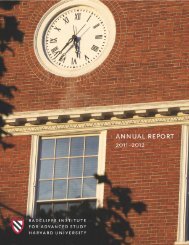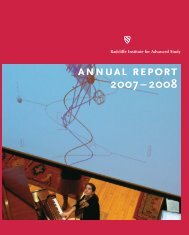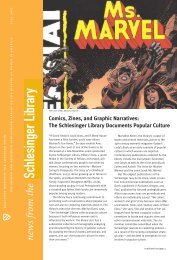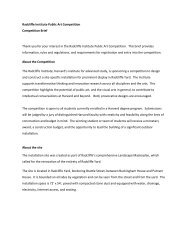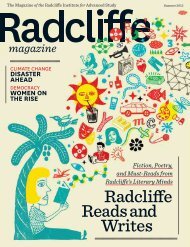Download PDF Version - Radcliffe Institute for Advanced Study
Download PDF Version - Radcliffe Institute for Advanced Study
Download PDF Version - Radcliffe Institute for Advanced Study
You also want an ePaper? Increase the reach of your titles
YUMPU automatically turns print PDFs into web optimized ePapers that Google loves.
February 2006<br />
1<br />
<strong>Radcliffe</strong> <strong>Institute</strong> Fellows’ Presentation Series<br />
“Sixties Activism and the Political Responsibilities of<br />
Universities”<br />
Julie Reuben, Harvard Graduate School of Education<br />
1<br />
Schlesinger Library Film Series<br />
Sisters in Cinema, directed by Yvonne Welbon<br />
Followed by a discussion with Lisa Simmons, Color of<br />
Film Collaborative<br />
3<br />
Public Discussion<br />
George Chauncey, professor of history, University<br />
of Chicago<br />
Cosponsored by the history department, the Charles<br />
Warren Center <strong>for</strong> Studies in American History, the<br />
Committee on Women, Gender, and Sexuality Studies, and<br />
the Arthur and Elizabeth Schlesinger Library on the<br />
History of Women in America<br />
7<br />
Public Lecture<br />
“Conflict and Displacement: Breaking the Cycle”<br />
Dennis McNamara, United Nations Inter-Agency Internal<br />
Displacement Division<br />
Cosponsored by the Carr Center <strong>for</strong> Human Rights Policy,<br />
the Harvard Humanitarian Initiative, and the <strong>Radcliffe</strong><br />
<strong>Institute</strong> <strong>for</strong> <strong>Advanced</strong> <strong>Study</strong> in coordination with its<br />
2005–2006 Voices of Public Intellectuals lecture series,<br />
War and the Displacement of People<br />
8<br />
<strong>Radcliffe</strong> <strong>Institute</strong> Fellows’ Presentation Series<br />
“Questions in Contemporary Chinese Cinema”<br />
Rey Chow, Brown University<br />
Exploring the Sky and Earth<br />
The <strong>Institute</strong>’s science programming, led by Barbara J. Grosz, <strong>Radcliffe</strong><br />
dean of science and Higgins Professor of Natural Sciences in<br />
the Faculty of Arts and Sciences’ Division of Engineering and Applied<br />
Sciences at Harvard, featured explorations of the sky and earth: a lecture<br />
series and panel discussion on astronomy and a symposium<br />
about the impact of humans on nature. As in previous years, these<br />
events brought prominent scientists to Harvard, where they shared<br />
their work-in-progress with students and faculty and strengthened or<br />
developed connections with colleagues in their fields.<br />
The first speaker in the astronomy lecture series was Ray Jayawardhana,<br />
an associate professor of astronomy and astrophysics at the<br />
University of Toronto, whose presentation was also the first Dean’s<br />
Lecture of the year. Jayawardhana described “hot Jupiters” that circle<br />
close to their parent stars, unlike our local Jupiter, which keeps<br />
a certain distance from the Sun. “It came as quite a surprise that<br />
there would be a Jupiter-like gas giant so close in, baked in the heat<br />
of its parent star,” he said. Other phenomena that interest him are<br />
brown dwarfs, which he described as “these strange beasts that are<br />
in between stars and planets.” Though they begin their lives looking<br />
shiny, brown dwarfs end up billions of years later looking like<br />
our oversized, cloud-covered Jupiter.<br />
In her lecture, Debra Fischer, an associate professor of astronomy at<br />
San Francisco State University, suggested that there’s an enormous<br />
range of solar-system architecture and that our solar system, with the<br />
Sun and its nine planets, may not be typical. “Perhaps anything that’s<br />
allowed by mechanics and the laws of gravity ends up as a possibility,”<br />
she said. Scientists have already discovered some 160 planets<br />
around distant stars, and more work remains <strong>for</strong> planet hunters.<br />
Elizabeth Lada, a professor of astronomy at the University of Florida,<br />
delivered a lecture in which she described how stars <strong>for</strong>m in<br />
clusters. “Most stars <strong>for</strong>m in what we call giant molecular clouds,”<br />
dark bodies filled with cold dust and gas, she said. “These clouds<br />
are the largest objects in the galaxy. They also happen to be the<br />
coldest objects in the universe,” just above absolute zero. She calls<br />
these frozen vapors the “prenatal birth sites of young stars.”<br />
Generations of women astronomers spoke at the panel discussion<br />
titled “The Sky’s Not the Limit: Women in Astronomy.” Five prominent<br />
astronomers in the Science Center and a sixth participating by<br />
audiotape spoke to a standing-room-only crowd about how they<br />
advanced in this male-dominated field. Several of the women emphasized<br />
an early passion <strong>for</strong> the night sky. E. Margaret Burbidge, a professor<br />
emerita of physics at the University of San Diego, described<br />
crossing the English Channel at night when she was four. “I’d never<br />
seen the stars be<strong>for</strong>e,” she said. “And I was sold, right there and<br />
then. Have been since.” Burbidge made important contributions to<br />
the field, including some of the earliest work calculating the masses<br />
of galaxies.<br />
C. Meg Urry, director of the Yale Center <strong>for</strong> Astronomy and Astrophysics,<br />
has used space telescopes to conduct a census of black<br />
holes in the early universe, among other achievements over the past<br />
twenty years. She stressed that the gender barriers women face in<br />
astronomy have not disappeared.<br />
Focusing on the planet we live on, a solemn message was delivered at<br />
a March symposium titled “Biodiversity in the Anthropocene: Perspectives<br />
on the Human Appropriation of the Natural World.” The symposium<br />
featured seven speakers from a range of disciplines, including<br />
agriculture, oceanography, and zoology. During the current “Anthropocene,”<br />
the geologic era dominated by Homo sapiens, we have left<br />
our mark on almost every other species. Between an eighth and a<br />
third of the earth’s five to ten million species are currently threatened<br />
by extinction. Fish stocks are diminishing, and coral reefs are dying.<br />
Big animals are perishing, and wild birds are disappearing. As Jeremy<br />
B. C. Jackson, the William E. and Mary B. Ritter Professor of Oceanography<br />
at the Scripps Institution of Oceanography, put it, “Everything<br />
we like is decreasing. Everything we don’t like is increasing.”<br />
To watch the three astronomers delivering their lectures, visit the following<br />
Web addresses: Ray Jayawardhana: www.radcliffe.edu/events/<br />
lectures/2005_jayawardhana.php; Elizabeth Lada: www.radcliffe.edu/<br />
events/lectures/2006_lada.php; Debra Fischer: www.radcliffe.edu/<br />
events/lectures/2006_fischer.php<br />
To watch the biodiversity conference presentation, visit<br />
www.radcliffe.edu/events/conferences/2006_biodiversity.php<br />
22<br />
www.radcliffe.edu



